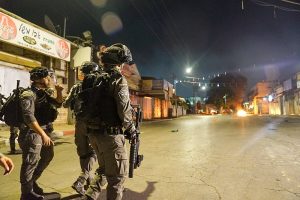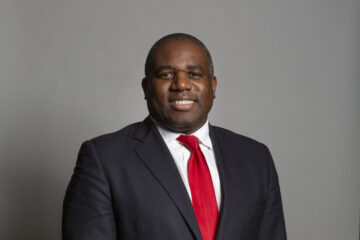
Israeli police in Lod. Credit: Israel Police, CC BY-SA 3.0.
After eleven days of fighting, an Egyptian-brokered ceasefire between Israel and the Hamas terror group was announced on Thursday night, and has since held.
What happened
- The ceasefire was announced late in the night of Thursday 20 May, coming into force at 2am on Friday 21.
- The announcement followed days of speculation around the possibility of a negotiated end to the violence.
- The ceasefire ended 11 days of war between Israel and Hamas, in which 242 people died and some 4,000 rockets were fired into Israel. Israel conducted 1,000 strikes on terrorist targets in Gaza.
- Ending the conflict has had political implications for attempts to form a coalition government in Israel, while efforts at reconciliation in Israel and rebuilding in Gaza have begun in earnest.
The ceasefire
The announcement of a ceasefire on Thursday followed days of speculation, in which rumours abounded and Hamas figures predicted one in the coming days. Israel’s security cabinet voted unanimously to approve the Egyptian initiative to stop the fighting, in the midst of international pressure including from US president Biden. Fireworks were set off in celebration in Gaza, East Jerusalem and the West Bank as the ceasefire commenced at 2am on Friday morning. Terrorist rockets continued and Israeli strikes on terrorist targets both ended about 10 minutes before the deadline. Although Hamas figures claimed to have extracted concessions from Israel, the Israeli government denied this and characterised the deal as a “mutual and unconditional ceasefire”.
Behind the scenes
The ceasefire was largely brokered behind the scenes by Egyptian and UN mediators, with input also from the U.S.
- Egypt worked to find a resolution acceptable to both sides, sending security delegations to Israel and the Palestinians to follow up on implementation and secure agreement on measures needed to maintain stability.
- Despite criticism from some far-left congressional Democrats, the Biden administration worked behind the scenes to shorten the conflict and to minimise casualties. The White House held more than 80 “engagements” relating to the ceasefire negotiations.
- The U.S. strategy appears to have relied heavily on other regional players, including Egypt, the Palestinian Authority and Qatar in the truce negotiations.
- Biden also blocked resolutions at the UN Security Council criticising Israel and calling for a ceasefire, believing that they would discourage the Netanyahu government from cooperating.
- Analysts have favourably compared Biden’s behind-the-scenes strategy with that during the 2014 war, in which US involvement enflamed tensions rather than resolving them.
- In a statement following the ceasefire, Biden vowed to continue what he called “our quiet and relentless diplomacy” towards a long-term settlement, and expressed “sincere gratitude” to Egyptian president Abdel Fatah al-Sisi for his mediating role.
Political fallout
The conflict and resulting ceasefire have had political implications in Israel itself, where coalition negotiations are ongoing following the fourth election in two years. Head of the opposition Yair Lapid, a leader of the anti-Netanyahu camp, has held the mandate to form a government since 5 May. During the conflict itself, the Islamist Ra’am party announced that it would suspend talks with the anti-Netanyahu “change bloc” in response to the outbreak of conflict. Further movement came when Naftali Bennett, leader of the right-wing Yamina party, similarly ended talks with the change bloc and indicated his willingness to support Netanyahu during the conflict.
With eight days left until his mandate expires, however, Lapid this week announced his first coalition agreement. In a joint statement, Lapid and Avigdor Liberman, leader of right-wing, fiercely secular Yisrael Beytenu, announced that Liberman would become finance minister should Lapid successfully form a government. Yisrael Beytenu MKs would similarly receive three other cabinet posts, as well as the powerful chairmanship of the Knesset Finance Committee. Lapid also signed a coalition deal with the centre-left Meretz party, with an increase to the health budget and climate change legislation. Further agreements are thought to be coming with Merav Michaeli’s centre-left Labor party, while Lapid is also in talks with the centrist Blue and White. However, in order to form a majority coalition, Lapid must also gain the support of either the right-wing Yamina and New Hope parties, or the Arab-majority Ra’am and Joint List. Acknowledging that this would be a challenge, Lapid has vowed to “turn over every rock in order to form a government”.
Rebuilding and reconciliation
Despite small-scale clashes between Palestinian protestors and Israeli police in Jerusalem, the ceasefire between Israel and Hamas appears to be holding.
- Israel has opened a crossing into Gaza, allowing food, fuel and medicine into the territory. Israel also lifted emergency restrictions inside its own borders.
- Visiting Israel, secretary of state Anthony Blinken promised to “rally international support” to rebuild Gaza while keeping assistance out of the hands of Hamas, which both Israel and the US recognise as a terrorist group.
- Blinken will visit Israel, the Palestinian Territories, Jordan and Egypt in his bid to shore up the ceasefire and launch the reconstruction effort.
- He also announced that the US would reopen its consulate general in Jerusalem in a move to restore ties with the Palestinian Authority, led by Mahmoud Abbas. This move has been seen as attempting to bolster the PA’s authority in opposition to Hamas, which has governed Gaza since 2006.
- The conflict also saw unprecedented levels of violence within Israel itself between Jews and Arabs. Thousands of Israelis rallied for reconciliation and coexistence in Tel Aviv at the weekend, while Blinken said that “healing these wounds will take leadership at every level”.
International Reactions
News of the ceasefire was welcomed around the world. The UN secretary general, Antonio Guterres, urged Israel and Hamas to observe the ceasefire and called on global leaders to develop a reconstruction package to “support the Palestinian people and strengthen their institutions”. US president Biden commended Israel for engaging with the ceasefire process, and gave his “full support to replenish Israel’s Iron Dome system to ensure its defences and security in the future”.
What next?
Should the ceasefire continue to hold, it will be an endorsement of Biden’s behind-the-scenes diplomatic efforts and evidence against the ‘megaphone diplomacy’ pushed by some of his critics. Whether the rebuilding and reconciliation processes will succeed in avoiding future conflict remains to be seen.

